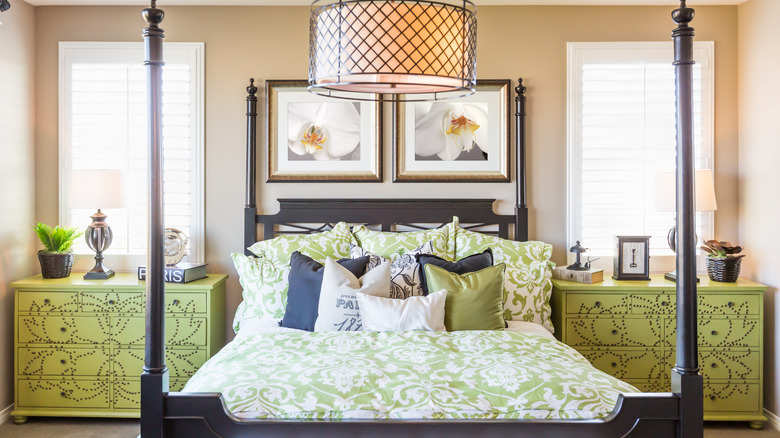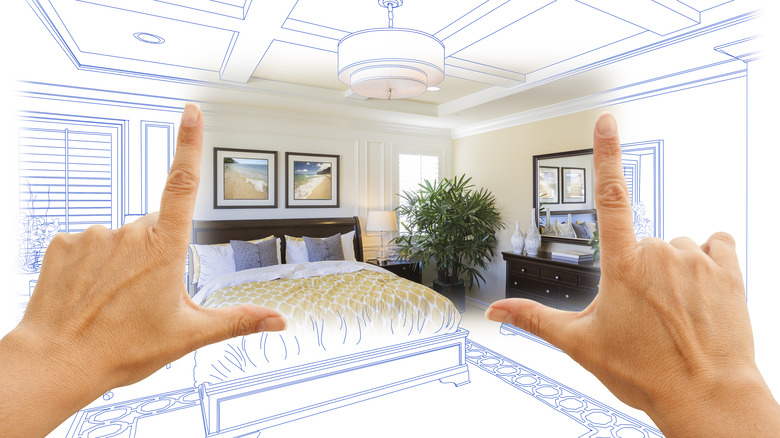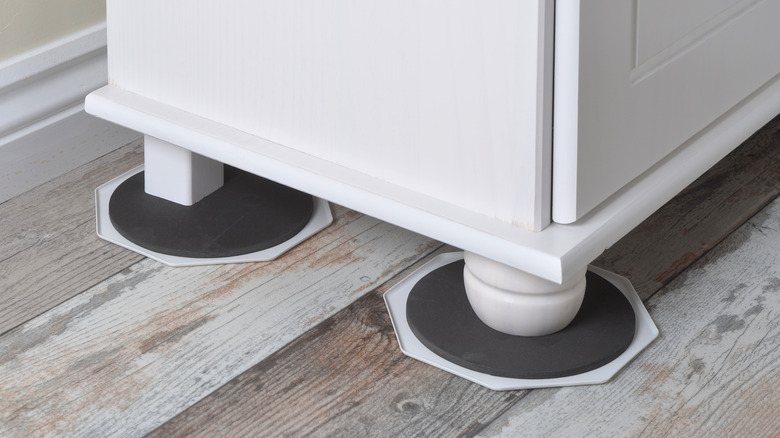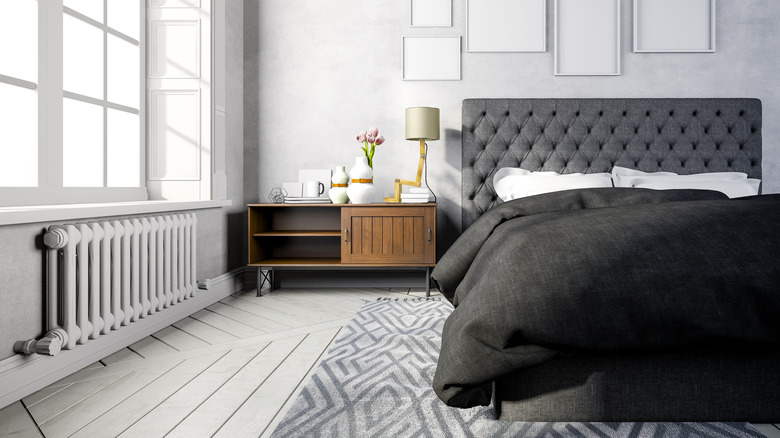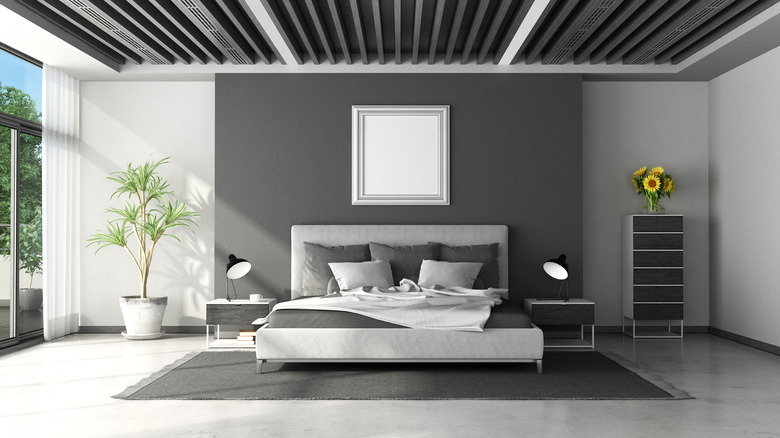Stress-Free Tips For Rearranging Your Bedroom
Your bedroom is the best place to experiment with design creativity. Since it's a private place just for you (and, perhaps, your partner), you should feel free to make it exactly as you desire. Hopefully, you already have all the necessary items, and your room just needs to be refreshed. Rearranging furniture comes naturally to some people, and they eagerly dive into color schemes and layouts; but for others, the task becomes an ordeal wrought with anxiety. Luckily, there are ways to manage the job that make it easier through a step-by-step process.
According to Psychology Today, the act, as well as the result of changing furniture placement, is often therapeutic. When we rearrange our rooms, we are shedding an old pattern and opening up for renewal. It gives us a chance to complete a project and to feel satisfied. Plus, the process almost always involves discarding unwanted or unused things, which frees up clogged energy and allows you to reconnect to your space.
Rearranging a room is healthy for your mind and also for your budget. By using the furniture you have and not buying everything new, you can focus on creativity and only purchase things to accentuate your updated design. Verlo recommends considering your furniture items to ensure you have everything you need. You might find that you have too many items for your space. It's healthy to let go of things that no longer suit your space.
Find inspiration, make plans, and measure
At the beginning of your project, take time to search online and in magazines for photos of bedrooms that inspire you. Incorporate those ideas into your new design. Parachute recommends laying these ideas out on a mood or vision board, which is a visual tool where all of your inspiration comes together in one place before implementing the changes in the actual room. A mood board can be as simple as a corkboard or as savvy as an online design tool. The point is to create a place where your eyes can feast on the ideas, allowing you to ruminate on the design plans.
The next step in the process, says Parachute, is to map out your room and the furniture layout on paper. You'll want to measure your room and each item to make sure it will fit where you intend it to be and then sketch it out so you can see how it should look. If you're more of a tech person, some apps allow you to do this (usually for a price); some focus on interior design, and others help more with floor plans. As you make your drawings, you may find that one of your biggest challenges is the size of the bedroom. If the room is small, Roomlay suggests using vertical space as much as possible to make sure your furniture isn't too big or plentiful for the space.
Prepare, clean, and declutter
Once the design has been sketched, you're ready for the physical part of the preparation, which involves cleaning, clearing, and purging. You'll want to remove as much from the bedroom as possible, so it's easier to place furniture where you want it to be. Declutter Our Home advises that you clean and declutter as you begin packing things up. The Rule of Three that applies to a whole house move is just as effective for a room cleanout. Make three piles: trash, donate/sell, and keep. It might be tempting to skip this part, but it's vitally important to your fresh start.
A Tidy Mind reports that, among the many visual benefits of a clean bedroom, a space free of clutter promotes more healthful sleep. Plus, having fewer things means you will spend less time chasing and cleaning dust, debris, and piles of stuff. By being selective in your surroundings and choosing items that only bring meaning to your life, you release yourself from the attachment to things, and the time they take up.
Move furniture with a little help
Injuries are common when it comes to moving furniture. Back and knee injuries are a big risk, according to A Smooth Move Removal, followed by sprained or broken ankles, cuts, scrapes, and bruises. So, if you have any physical limitations, it's best to have someone do the moving for you. And it's always a good idea to dismantle as much as possible and use the right tools for moving.
Furniture sliders are inexpensive disks designed to be placed under the legs of heavy furniture to help them glide across the floor easily. These can be purchased at many local retailers and hardware stores. For stacks of boxes and other large items, a dolly can be put to good use. A to Z Valleywide Movers also recommends using furniture straps to move anything large or small that might be cumbersome. The important thing is to protect yourself and others from injury by planning ahead and having these heavy lifters on hand during the rearranging phase.
Start low and go big
The bedroom has been cleaned and cleared. You're ready to bring items back in, but where should you start? Start low — the first thing to bring back are rugs so that you don't have to lift furniture later to put the floor coverings into place. If you forgot to draw them on your sketch, this is the time to play around with different placements. Once you've decided where the rugs will go, it's time to haul in the biggest piece of furniture — the bed.
Overstock recommends leaving enough room to comfortably walk around the bed. Another tip from Overstock is to focus on the balance of the room by bringing in another heavy item, such as a dresser or chair, to place opposite the bed. Then use nightstands next to the bed. Always think of the functionality of your room, and don't be afraid to alter your plans if you find that your original design isn't working.
Finalize the details
If you really want to change the look of your bedroom, spend some time updating the details as well. Many of these things you can do by using items you already have in other rooms around your house or by thrift shopping. The simplest way to complete your update is to change your color scheme, says My Decorative. You can do this by adding new bed linens and throw pillows to your bed, updating window coverings, and making sure your rugs blend with the new look.
Another helpful tip is to pay attention to lighting. If your lamps are dated, replace them entirely or buy new shades to give them a fresh look. Adding new art to the walls or on shelves can also have a positive impact on your design. And don't let clutter creep back in. If you spend any money on your refresh, apply it to out-of-sight storage solutions to keep your newly designed space tidy and welcoming.
